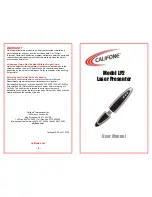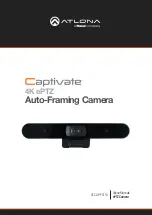
14
Chapter 4
Image Calibration
Images of stars, nebulae, etc. taken by the camera are called “light images”. Image
calibration means calibrating the CCD with a BIAS field, a DARK field, and a FLAT field
so to remove artifacts and nonuniformities from the light images. This includes
removing thermal noise of the CCD, dark spots caused by dust on the surface of the
CCD and elsewhere in the optical train, and variations in brightness caused by
vignetting. Image calibration is a critical step for serious astronomical photography.
•
In order to obtain accurate calibration information, you need to use the QHY8L
temperature controller. The CCD should be set in regulated temperature state,
and the temperature should be the same when shooting when shooting light,
dark, and bias frames.
•
The temperature control of EZCAP is located in Temp Control of the Setup menu
bar. Select temperature regulation on the right section of the Temp Control
window to set the temperature what you want. Then select the Auto Control,
which will put the CCD under constant temperature control.
•
It will take for some time to achieve the target temperature for the CCD. Wait
until the temperature of the CCD stabilizes, then start to shoot calibration
images.
The calibration principle of CCD image:
Calibrated image= (L-B) - (D-B) / (F-B) - (DF-B)] = (L-D) / (F-FD). Here L is the
actual shooting image, D represents Dark Frame image, B represents BIAS image, F
represents Flat Frame image, DF represents Dark Flat Frame image. Generally
speaking, the Flat Frame image is bright, so we seldom use the Dark Flat Frame image.
Hence we can ignore DF-B, so the calibrated image = (L-D) / (F-B).
Note: When we stack a lot of BIAS or DARK images, there will be vertical stripes on
the stacked image. This is a normal situation; these stripes won't appear on the
calibrated image.
Method to Capture Calibration Images:
BIAS
BIAS image refers to the image for which exposure time is zero. You need to avoid any
light entering into CCD when you are shooting. Therefore, you need to cover the lens
cap of camera. Set the exposure time to 0, set low readout speed, set the binning
model to 1*1, then shoot 10-50 BIAS images. Save them, and then use stack software
(select average model to stack, not matching stack) to get a BIAS master image. And
save this image.
Summary of Contents for QHY8L-C
Page 1: ...1 QHY8L C Instruction Manual 1 4 13...
Page 22: ...22 Chapter 7 Accessories and Interface Specification Accessories included with camera...
Page 23: ...23 QHY8L Interface Specification...
Page 24: ...24 Chapter 8 QHY8L Mechanical Dimensions...
Page 25: ...25 Chapter 9 Clip Installation 1 Clip for QHY8L QHY8PRO QHY10 QHY12 camera...
Page 26: ...26 2 Before installing the clip 3 Unscrew two screws at the back of the camera...
Page 28: ...28 6 The front of the clip 7 The back of the camera...















































